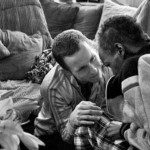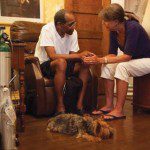Some twenty or thirty people—nurses, volunteers, aides, visitors, activists—had gathered at Joseph’s House at 6:30 in the evening.
They heard “Amazing Grace” played by a bagpiper from the firehouse. They were welcomed by Joseph’s House Executive Director Patty Wudel and were led in a light-sharing ceremony by volunteer Andrea Woods. Candles lit and spirits high, they embarked on a walk through Lanier Place in Adams Morgan, through the one-way section which makes it easier for the ambulances and fire engines to come in and out of the local firehouse. They walked past all the houses, the night having come on, the candles acting as pathfinders through sidewalks full of blustered leaves. Around the block, past the house next to the fire station where the old lady from the Carolinas had lived for so many years, and they were home again.
Joseph’s House staff member Kate Lichti read a poem called “Beannacht,” or “Blessing,” and they shushed their candles in the yard and went inside.
I came in behind them, late through faults entirely my own, and saw the extra chairs for the viewing of the Showtime documentary, “The Other City,” about the continuing rise of AIDS in Washington DC.
They were bringing in pizza and assorted snacks and lemonade and iced tea into the dining room, where the counters and walls were alive with the pictures of laughing, smiling men and women, almost all of whom are now gone.
It was World AIDS day at Joseph’s House, self-described as a compassionate community for homeless men and women at the end of life, founded in 1990 by Dr. David Hilfiker.
“We gathered tonight to celebrate Worlds AIDS day, and to celebrate the lives of all the men and women, over 300, who have died here,” Ms. Wudel said.
Mercelda Williams, a long-time personal care aide here, spotted me. “You’re the guy with Bailey,” she said.
That would be my dog Bailey, who is well known here, even though there is a new house dog, a cat named Romeo and a fierce female Yorky named Ajax, who, when it comes to Bailey, becomes fanatically territorial.
There’s a reason to bring up my dog. We’d always walked past the big, roomy house on the corner of Lanier Place and Ontario, with its peeling bark trees, its garden tools in the yard, the well-lit windows reflecting warmth, the gray statue of Mother Mary. We saw the men sitting on the porch, the employees, nurse’s aides, young, apple-faced volunteers, and a man in brown monk robes. I knew it was a hospice for homeless men and women with terminal illnesses, primarily AIDS, but also cancer.
It was a home on the street, really, very much a part of the neighborhood. Sometimes there were celebrations and gatherings there, and ambulances and hearses would stop there, which was a part of the life of the home. Some days Wudel would greet us warmly, as she does most people, and she took a liking to Bailey, as do most people.
Bailey, a Bichon Frise, wears his natural, little-dog cuteness, with a certain amount of diffidence, volunteering affection grudgingly. But it was Bailey who took an interest in the residents at Joseph’s House.
We would walk by—over the years a few thousand times, most likely—and Bailey would stop and look up. And the men there would respond. “That sure is a cute dog,” one or the other would say. And Bailey, instead of moving briskly on, would stop and look back. His tail would wag. Soon, some of the men would come down and pet him, and he stood still for it. I guess the word went out. Pretty soon, we’d be on the other side of the street and would hear, loud and clear: “Hey, Bailey, how you doin’?”
“That was Jesse,” Williams said. “He started that ‘Bailey’ stuff. Lots of them. They just naturally got to liking him.”
And Bailey would respond in kind, which was so rare as to require noting. He and I turned the corner with Fred and Donald. Fred was a carpenter by trade—he made the Welcome sign at the top of the porch—and his best friend there was Donald. Fred suffered from terminal lung cancer. When they were out on the porch early in the morning, Bailey would not only stop, but would hop up the two sections of stairs to see one or the other.
Donald, a navy veteran, a thin, lively man who refused to bow to the idea of dying, was out on the porch early in the morning, and Bailey came running up the stairs. “Yo, Bailey,” he said, opening the door.
“Fred,” he said, “you better get on out here. Bailey’s up here.”
“I think he’s sleeping on the couch,” Donald said. But Fred came out, walking slowly. It was near the end days of his illness, but he came out in the cold to greet Bailey.
The two of them showed up in November two years ago to vote. “It’s a history day, isn’t it?” Fred said. “It’s a great day. I had to do that.” It was also an act that spoke directly to the future that Fred would not be occupying, and he knew that.
Donald, it turned out, was one of the people who survived his illness and returned to the world outside of Joseph’s House. He would come back, show up periodically, and if I saw him, he asked about Bailey.
If this sounds prosaic, even whimsical and sentimental, it’s not meant to be. I began to understand what was happening at Joseph’s house, which was just this kind of thing. “We treat people with unconditional love,” Wudel said. “Nobody has to earn love, nobody should have to do it.
“It’s about respect. It’s about being curious about people’s lives. It’s about learning how to live a full live in the process of dying. There is a deep exchange that goes on here. We are not naïve in the face of death. We feel the loss, too.”
And life is all about greetings, the smell of fried eggs, fading light at dusk, early morning cold on a porch, people sharing moments by extending their time, life and hands.
When we pass by, I seem to remember them all—the young white man who made every effort to be out in the community, shopping at Safeway, going to the Deli, relatives showing up on birthdays, twenty-something volunteers on the porch listening to the latest resident talk about his or her life, the voices not quite carrying but being a musical murmur. Sometimes kids and men and women would be gathering, and there were tears. And you knew that the tears were a part of things here, and there would be somber faces in the morning here.
Daily life goes on there, and the house and the people in it are very much a part of the neighborhood, the street with its winter potholes, the bright street lamps, the ambulances coming out of the fire house, all the people with dogs walking dogs, the burst of babies in their carriages. There is no spot on the stairs or on the sidewalk that says this is where Joseph’s House ends and the neighborhood begins.
No one, it seemed to me, retreats into a solitary death there. They live in company even at the last. Walking by, we know all that, and the vibrant lives still lived, and those remembered.
“Who knew,” I thought early on.
I think Bailey knew.





